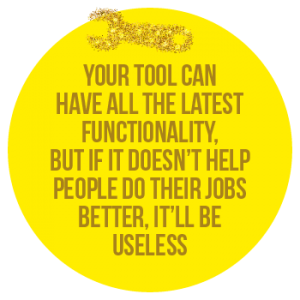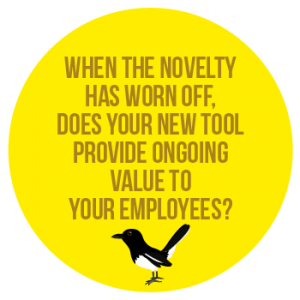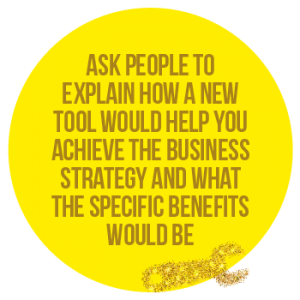Magpie syndrome: an irrational affinity for shiny objects. Or in the case of IC pros, the latest digital bling that promises to transform the way your business communicates. We’ve all experienced the intoxicating sensation of feeling the holy IC grail is within our grasp only to find it’s just not that simple
So, whether it’s a new intranet, ESN, email newsletter or video platform, here are our top tips for keeping magpie syndrome at bay, and choosing a technology that’s right for your organisation.
Face-to-face continues to reign supreme. And despite the buzz around ESNs, the most frequently used channels are still the intranet, email, e-newsletters and video.
But is it the fault of the tools, or that organisations often experience magpie syndrome when a shiny new piece of technology is waved in front of them? How many of us truly understand what’s involved in successfully rolling out digital platforms or if they’re even right for our organisation?
For many, digital tools can be the silver bullet they need, but one size does not fit all. So, if you’re thinking about introducing a digital tool into your organisation, here are some of the key things you need to think about.
Do some digging
Your organisation could be a treasure chest of digital solutions you aren’t even aware of. Do you know what other tools your IT team are investigating or even what capability they have themselves to build something bespoke? For example, it would be foolish to charge full steam ahead with an IBM platform if your IT team have just invested in Microsoft 365, or vice versa.
And don’t assume that just because you invite an IT colleague to a meeting about the shiny new tool you’re investigating, they’ll volunteer this information. Sometimes you have to ask a direct question to get a direct answer.
TOP TIP: conduct an audit of your current channels and tools to really understand the current situation and other impacting factors so you have a clear picture of what your organisation already has and may need.
Power to the people
As part of any audit, ask your employees how effective they find the current tools, how they use them, how they would like to be able to use them, and at the crux of it, what they need to be able to do their jobs.
Ultimately, your tool can have all the latest functionality, but if it doesn’t help people do their jobs better or more efficiently, it will be useless.
TOP TIP: run focus groups with employees if possible to get a detailed understanding of how they need to use technology, and if you already have it what they would and wouldn’t miss if you took it away.
Do you know your AD from your DC?
No, we’re not talking about a bad AC/DC cover band. Chances are if you’re like most IC pros, you’ll have a good grasp of the basics, but you’re no tech whizz. And you don’t need to be, but you do need to understand who should be part of the conversation and what questions to ask.
For example, have you considered that the people directory on your new intranet will need to be populated through active directory (AD)? Do you have one? Does it work effectively?
And what about any existing tools you have – are there confidential areas you can’t see that are integral to some parts of the business? Will your new tool be compatible with your other systems?
It’s important that you don’t talk about the tool in isolation, and that you understand what else needs to be considered, so make sure key stakeholders are part of the conversation. And don’t forget the magic question – whether to an external supplier or colleagues from other departments: “Is there anything else I should know?”. You’d be amazed what people bring up that can be pretty integral to your project.
TOP TIP: ask lots of questions and do bring experts in early on. As communicators we know what it’s like to be called into a project at the 11th hour – collaboration is more likely if people feel involved and that their knowledge and expertise is respected.
It’s what’s on the inside that counts
Everyone loves a shiny new piece of tech, but the true test of success is when the novelty has worn off. Does it provide ongoing value to your employees? Ultimately, a tool will only be as good as the content you put in it. Whether it’s an intranet, video, email newsletter, you need to have a content strategy and engaging, useful and relevant content.
TOP TIP: communicate the purpose of a new tool to people so they understand what type of content they’ll find on it and how they should be using it.
Time for change
Depending on your organisation and the tool you choose, an element of behavioural change may be required. For example, if people are used to an intranet being a static repository of information, and you implement a collaboration tool, it’s an entirely different way of working, and puts the onus on already stretched employees to take responsibility for participating.
It can absolutely work, but don’t underestimate the amount of time and resource you’ll need to properly embed a new tool, to train people on how to use it, and to community manage it to ensure it delivers what you need it to.
TOP TIP: if the tool you’re looking to implement is an ESN or has significant collaborative elements, consider hiring a community manager, who can be responsible for engaging people with the tool and ensuring it runs effectively, leaving you to get on with the many other demands on your time.
The long wow
Creating a long wow with your new tool means viewing it as a product rather than a project. As technology advances you want your tool to be able to evolve with it. So you need to see it as an ongoing piece of work, where updates and additions will be rolled out over time, rather than doing a big bang launch and then nothing else for several years. Evolving the product also helps to maintain the interest of your employees.
TOP TIP: like with a community manager who will run the platform once it’s up and running, the development of any new piece of technology really requires a focused product manager who understands both the technical elements and the engagement elements. So, it’s worth considering if you need a specific resource in your team, to solely focus on developing, rolling out and evolving that product, rather than see it as an extra to already jam packed to-do list.
Do you need it?
Just because many companies are adopting new ways of working through new technology, doesn’t mean everyone has to follow suit. Some organisations and their cultures just aren’t ready for the type of change new technology can bring, or it simply won’t add any value to the type of work you do and the way you do it.
And to be fair it’s not often IC pros that are dazzled by digital bling. Rather we need to harness the enthusiasm demonstrated by colleagues from elsewhere in the business and channel it in other ways or help them to scale it back, to ensure any new shiny, corporate toys, are needed, appropriate and feasible.
TOP TIP: as with any request to the internal comms team, ask people to explain how a new tool would help you achieve the business strategy and what the specific benefits to your people would be. If people struggle to answer those questions, your colleague may be experiencing magpie syndrome and will need to be gently coaxed away from the digital bling.
Technology isn’t going away, but that doesn’t mean you need to embrace it for the sake of it. Magpies lurk everywhere in organisations, so as IC pros we need to be ahead of the game. We need to understand the basics and be able to tie this in with a broad line of sight across our organisations to make informed decisions about what our people, and our businesses, really need.
By Helen Deverell for Alive!
















